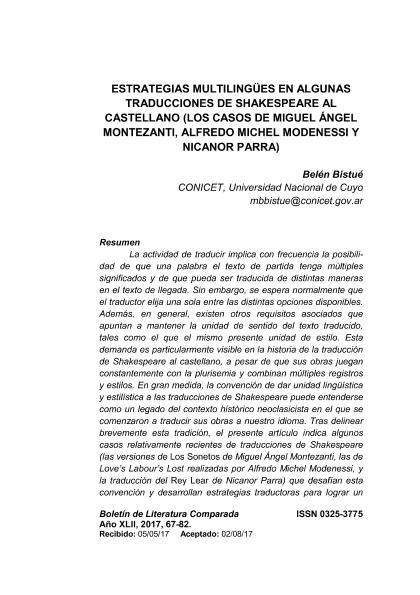Artículo
La actividad de traducir implica con frecuencia la posibilidad de que una palabra el texto de partida tenga múltiples significados y de que pueda ser traducida de distintas maneras en el texto de llegada. Sin embargo, se espera normalmente que el traductor elija una sola entre las distintas opciones disponibles. Además, en general, existen otros requisitos asociados que apuntan a mantener la unidad de sentido del texto traducido, tales como el que el mismo presente unidad de estilo. Esta demanda es particularmente visible en la historia de la traducción de Shakespeare al castellano, a pesar de que sus obras juegan constantemente con la plurisemia y combinan múltiples registros y estilos. En gran medida, la convención de dar unidad lingüística y estilística a las traducciones de Shakespeare puede entenderse como un legado del contexto histórico neoclasicista en el que se comenzaron a traducir sus obras a nuestro idioma. Tras delinear brevemente esta tradición, el presente artículo indica algunos casos relativamente recientes de traducciones de Shakespeare (las versiones de Los Sonetos de Miguel Ángel Montezanti, las de Love’s Labour’s Lost realizadas por Alfredo Michel Modenessi, y la traducción del Rey Lear de Nicanor Parra) que desafían esta convención y desarrollan estrategias traductoras para lograr un rescate de la multiplicidad lingüística que caracteriza a las obras del poeta y dramaturgo inglés. The activity of translating frequently implies the possibility that a word in the source text has multiple meanings and that it can be translated in different ways in the target text. Yet, it is normally expected that the translator will choose only one option among the different possibilities. In addition, there are usually other associated requirements that aim at maintaining unity of meaning in the text, such as the call for stylistic unity in the translation. This requirement is particularly visible in the history of Spanish translations of Shakespeare, even when his works constantly play with polysemy and combine multiple register and styles. To a large extent, the convention of giving linguistic and stylistic unity to Sakespeare’s translations can be understood as a legacy of the neoclassicist context in which his works began to be translated into Spanish. After briefly delineating this tradition, the present article signals some relatively recent translations of Shakespeare (the versions of The Sonnets made by Miguel Ángel Montezanti, those of Love’s Labour’s Lost by Alfredo Michel Modenessi, and the translation of King Lear by Nicanor Parra) that challenge this convention and develop translation strategies that can rescue the linguistic multiplicity that characterizes the works of this English poet and playwright.
Estrategias multilingües en algunas traducciones de Shakespeare al castellano: los casos de Miguel Ángel Montezanti, Alfredo Michel Modenessi y Nicanor Parra
Título:
Multilingual Strategies in Spanish Translations of Shakespeare: the Cases of Miguel Ángel Montezanti, Alfredo Michel Modenessi, and Nicanor Parra
Fecha de publicación:
12/2017
Editorial:
Universidad Nacional de Cuyo. Facultad de Filosofía y Letras
Revista:
Boletín de Literatura Comparada
ISSN:
0325-3775
Idioma:
Español
Tipo de recurso:
Artículo publicado
Clasificación temática:
Resumen
Archivos asociados
Licencia
Identificadores
Colecciones
Articulos(CCT - MENDOZA)
Articulos de CTRO.CIENTIFICO TECNOL.CONICET - MENDOZA
Articulos de CTRO.CIENTIFICO TECNOL.CONICET - MENDOZA
Citación
Bistué, María Belén; Estrategias multilingües en algunas traducciones de Shakespeare al castellano: los casos de Miguel Ángel Montezanti, Alfredo Michel Modenessi y Nicanor Parra; Universidad Nacional de Cuyo. Facultad de Filosofía y Letras; Boletín de Literatura Comparada; XLII; 12-2017; 67-82
Compartir




